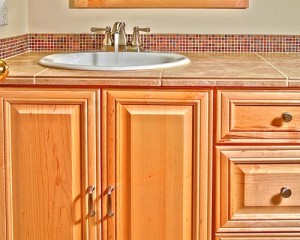For years, designers and families have agreed that the kitchen is the heart and soul of the home. The living and dining rooms are for formal entertaining, bedrooms and bathrooms are rather private spaces, but the kitchen is where family and friends gather for informal interaction. It is obviously the source of the delicious meals and snacks that the family shares, whether they are consumed in a formal dining area, in front of the TV, or at the kitchen table.

The kitchen is first and foremost a work space. Whether that workspace is closer to a workshop or an artist’s studio mostly depends on the attitude of the one doing the work. That attitude can be greatly influenced by the décor of the kitchen, and an very important element of the overall atmosphere is the cabinetry.
Most designers like to begin by looking at the cabinet exteriors, because that is the visual element that their customers and their friends will see. In keeping with the attitude that the kitchen is a work space, it may be more useful to start with the inside of the cabinets first.
Just like in any other workshop, the kitchen cabinets will need to neatly and safely store tools and materials. They will need to be large enough to organize the materials and the tools need to be safely and quickly accessed.
Rather than the power saws and drill press in a workshop, the “power tools” in the kitchen are usually small (and not so small) appliances. These can include blenders, slow-cookers, can openers, stand mixers, toasters, the list goes on. All too often these appliances end up cluttering an already limited amount of counter space. Kitchen counters are the cook’s workspace, so they need to be as uncluttered and easy to clean as possible.
It is OK to leave an appliance that is used on a daily basis on the counter top, but if not used often, it is soon in the way. A better solution is an “appliance garage”. This can be a slightly over-sized cabinet to keep your appliances clean and out of the way.
Another very useful cabinet is a spice drawer near, but not over the cook top. A spice rack is sometimes used as a decorative element, but it may be better to keep your spices out of sight and not exposed to the heat of cooking.
The material choice for cabinet interiors is usually between wood, either plain or painted, and melamine or laminate surfaced. Melamine has a definite advantage; not only are the bright white bright interiors easy to see into, the smooth surface is easy to keep clean.
The cabinet fronts are the real decorative element in the kitchen, and can help to set the whole mood of the work place. The selection runs from fancy to functional, so there are many options to find what suits your taste. Raised panel wooden fronts are classic, but the more complex the design, the more work they will require to keep clean.
Glass front cabinet doors can be beautiful, but not only do they require constant attention to keep clean, they will require you to keep the inside of the cupboards neat as well- you can’t hide a mess behind glass. Plain, smooth front doors, whether laminate or wood fronted, are very functional and practical. However, there is no getting around the fact that they can be sterile and even boring to look at.
